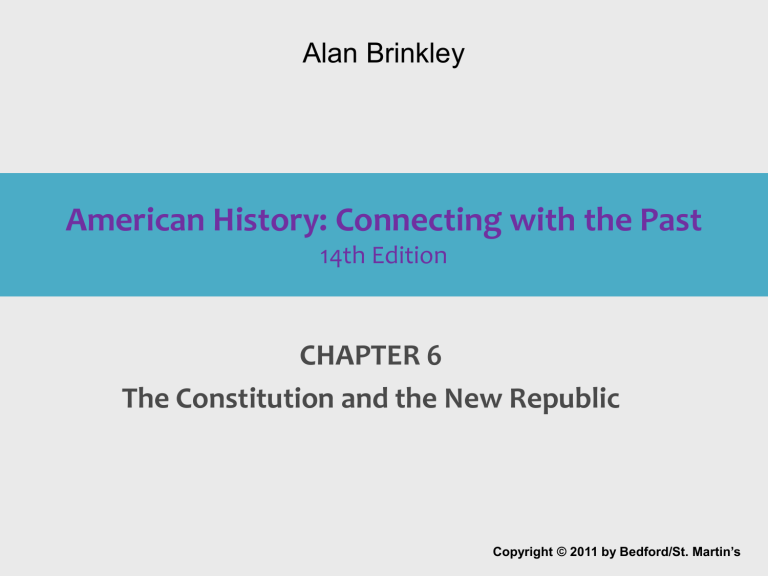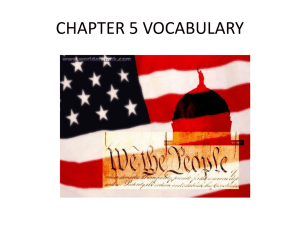Chap06

Alan Brinkley
American History: Connecting with the Past
14th Edition
CHAPTER 6
The Constitution and the New Republic
Copyright © 2011 by Bedford/St. Martin’s
Living in the Shadow of Revolution
1.
Revolution introduced unintended changes into American society
2. Challenged hierarchical social relations
3. Raised fundamental questions about the meaning of equality
African Americans in the New Republic
1. Abolitionist sentiment spread in wake of the
Revolution
John Woolman
2. African Americans embraced Declaration’s stress on natural rights
3. African American intellectual success made it hard to deny their equality
Benjamin Banneker, math and astronomy
Phyllis Wheatley, poetry
African Americans in the New Republic: Phillis
Wheatley
African Americans in the New Republic
1.
Northern states
By 1800, slavery was legally dying in North
Racism and segregation remained
2. Southerners debated abolition
Some individuals freed slaves
Economic motives overcame republican ideals
Cotton gin breathed new life into slavery
The Constitution of 1787
1. The Rise of a Nationalist Faction
Money Debates
2. The Philadelphia Convention
The Virginia and New Jersey Plans
The Great Compromise
Negotiations over Slavery
National Authority
The Constitution of 1787
1.
The People Debate Ratification
The Antifederalists
The Constitution Ratified
Independence Hall, Philadelphia
The
“Virtuous
Republic”
1.
Govt. gets its authority from the citizens.
2.
A selfless, educated citizenry.
3.
Elections should be frequent.
4.
Govt. should guarantee individual rights & freedoms.
5.
Govt.’s power should be limited [checks & balances].
6.
The need for a written
Constitution.
7.
“E Pluribus Unum.” [“Out of many, one”]
8.
An important role for women raise good, virtuous citizens.
[“Republican Womanhood”].
Inventing a Federal Republic:
The Virginia Plan
1. Central government may veto all state acts
2. Bicameral legislature of state representatives
One house elected, the other appointed
Larger states would have more representatives
3. Chief executive appointed by Congress
4. Small states objected to large-state dominance
Inventing a Federal Republic:
The New Jersey Plan
1.
Congress given greater taxing and trade regulation powers
2. Each state would have one vote in a unicameral legislature
3. Articles of Confederation otherwise untouched
Inventing a Federal Republic:
William Patterson
Compromise Saves the Convention
1.
Each state given two delegates in the Senate—a victory for the small states
2. House of Representatives based on population—a victory for the large states
All money bills must originate in the House
3. Three-fifths of the slave population counted toward representation in the House
Compromising on Slavery
1.
Issue of slavery threatened Convention’s unity
Northerners tended to be opposed
Southerners threatened to bolt if slavery weakened
2. Slave trade permitted to continue to 1808
3. “Great as the evil is, a dismemberment of the Union would be worse.”
—James Madison
We, the People
1. Convention sought to bypass vested interests of state legislatures
2. Power of ratification to special state conventions
3. Constitution to go into effect upon approval by nine state conventions
4. Phrase “We, the People” made Constitution a government of the people, not the states
Signing of the Constitution
Federalists and Antifederalists:
Federalists
1.
Supported the Constitution
2. Name suggests they supported less of a strong central government than they did
3. Well-organized
4. The Federalist Papers
Federalists and Antifederalists:
Antifederalists
1.
Opposed the Constitution
2. Distrusted any government removed from direct control of the people
3. Suspected the new Constitution favored the rich and powerful
4. Their ideas later reflected in the age of Andrew Jackson
The Jefferson Idyll
The Hamilton Idyll
A House Divided Against Itself Cannot Stand
Federalists and Antifederalists:
Progress of Ratification
1.
No clear correlation between social status and support for
Constitution
2. Succeeded in winning ratification in eleven states by June
1788
3. November 1789—North Carolina ratified
4. May 1790—Rhode Island ratified
5. Americans closed ranks behind the Constitution
p176
Adding the Bill of Rights
1.
The fruit of Antifederalist activism
2. Adding Bill of Rights forestalled Second Constitutional
Convention
3. Purpose was to protect individual rights from government interference
Adding the Bill of Rights
1.
Rights included:
Freedom of assembly, speech, religion, the press, and bearing arms
Speedy trial by a jury of peers
No unreasonable searches
2. First ten amendments added by
December 1791
Adding the Bill of Rights








